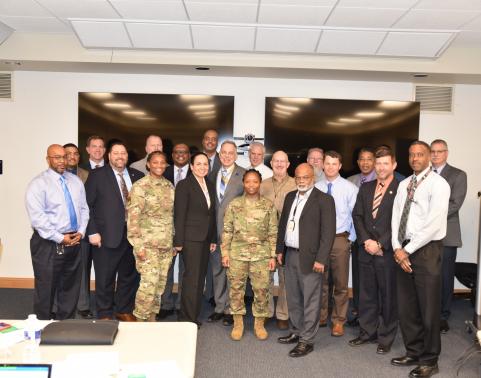PM DCATS Leads Modernization of Army Installation Public Safety Communications

The Project Manager Defense Communications and Army Transmissions Systems (PM DCATS) recently conducted a two-day “scrum” meeting at the Defense Acquisition University (DAU) on Fort Belvoir to address the emerging public safety communication requirements for Army installations worldwide. Tim McConvery and Greg Prothero, two DAU requirements division facilitators, facilitated the meeting, which was held in advance of the advent of COVID-19 and the Virginia stay-at-home order.
“The intent of the scrum was to quickly draft a capability development document (CDD) with input from all the stakeholders involved in Army installation public safety communications,” said acting product lead for Land Mobile Radio (LMR) EJ Wasikowski.
The CDD will capture the information necessary to develop a proposed program. In this case, the CDD drafters used an evolutionary acquisition strategy to outline the emerging technologies that offer affordable incremental improvements to the Army’s existing public safety capabilities at installations worldwide.
Wasikowski explains that “the urgency of this CDD is paramount as we rapidly modernize and migrate to various new systems within the base emergency communications and public safety communications realms.”
LMR’s mission, under PM DCATS, is to modernize Army non-tactical LMR systems within the continental United States and the Pacific in support of installation public safety organizations and functions, which includes first responders, force protection and other installation management functions.
LMR solutions typically require local, state, and federal mutual aid interoperability, advanced encryption standards, and priority queuing for life and safety communications. To incorporate emerging new requirements into the product line, LMR needs this new CDD to define the new requirements for the Army with input from all possible stakeholders.
“There are multiple disparate systems that all have interdependencies and interoperability requirements to function like a system of systems,” said Wasikowski. “It is important to strive to unite these systems into one capability as a system of systems to allow for funding of the disparate programs and to work towards a solution that will enterprise these systems and to allow them to communicate both internal to the Army but jointly as well.”
The scrum team included Patrick Barnette, the Program Executive Office for Enterprise Information Systems’ liaison to the Army's Network Cross-Functional Team (N-CFT), whose charged with tackling the Army's modernization priorities, driving requirements, and delivering a Unified Network, which incorporates both the integrated tactical and enterprise network.
Barnette explained the value of the new CDD to the N-CFT. “Less prescriptive integrated requirements are key to the Army’s modernization strategy and allow the Army flexibility for rapid and regular insertion of industry improvements. This requirements document and other enterprise network efforts support applications, network services, and/or transport systems to enable networking capabilities from the Enterprise level to the Tactical edge.”
Wasikowski explains, “Our ongoing efforts will serve to realign the funds from multiple program evaluation groups (PEG) into one and strive not to have these systems fight against warfighter needs in the equipping PEG but rather compete in the installation PEG to better serve posts, camps, and stations as we modernize and work to develop stronger more assured communications for future Army bases.”
On the last afternoon of the scrum, PM DCATS Col. Enrique Costas spoke to the team. ”These exercises are vital because they help define the network requirements for systems that serve the community inside the post -- from law enforcement and fire protection to security and other emergency services.”
In closing, Col. Costas awarded challenge coins to team members to show his appreciation for their expertise and time on this foundational document.
“This was a great deal of work, but it’s important,” said Costas. “It will help us move forward toward vital communication solutions.”
Related News
-
Jason Morneault assumes command of Wideband Enterprise Satellite Systems
August 22, 2023On June 30, Project Manager Integrated Enterprise Network (IEN) conducted an assumption of charter ceremony for the Wideband Enterprise Satellite Systems (WESS) Product Management Office. -
Joe David values determination, hands-off leadership and family
June 27, 2023“You must want it mentally and you must show it physically, giving it your all.”
As an aspiring high school football player, Joe David received this advice from his father.
-
Darius White Explains the Power of Storytelling
April 26, 2023“Storytelling is a way to connect with people, even if it is fanciful or scientific, on another level,” said Darius White.
Work for Us
Join a winning team! Search for job opportunities with PEO Enterprise.
Work with Us
Help support important missions. Explore ways your company can work with PEO Enterprise.